
Mid 20th Century Latticino Murano Glass Cup and Saucer
A latticino Murano glass cup and saucer, mid 20th century, the cup 8 cm high

Murano Latticino Slipper and Bimini Glass Basket Ornament Set
A fine Murano latticino and red glass slipper ornament with gilt foil inclusions, together with a Bimini glass basket, (2 items), the slipper 17 cm long

Mid 20th Century Murano Blue and White Latticino Glass Bowl
A Murano blue and white latticino glass bowl, mid 20th century, 6 cm high, 13 cm wide

Signed John Deacons Porthole Cameo Paperweight, Scotland 2006
A signed porthole cameo paperweight by John Deacons, Scotland, 2006, the sky blue double layered porthole paperweight with a suspended latticino globe featuring clematis and pansy flowerheads, signed to pontil with a miniature cane, Jd 2006, with Scotch…
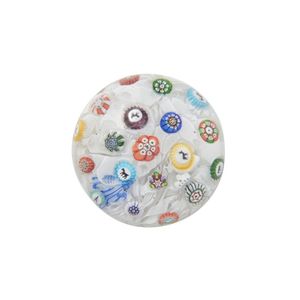
Baccarat Paperweight with Millefiori Canes and Ten Gridels
A large Baccarat paperweight, with millefiori canes and ten gridels (swan, elephant, deer, monkey, dog, goat, horse, moth, cockerel and pheasant) on latticino ground, 8.5 cm diameter

Mid 20th Century Murano Latticino Glass Bowl, 18cm Wide
Murano latticino glass bowl, mid 20th century, 18 cm wide

1950s Murano Latticino Glass Decanter: 35cm High
A Murano latticino glass decanter, circa 1950s, 35 cm high
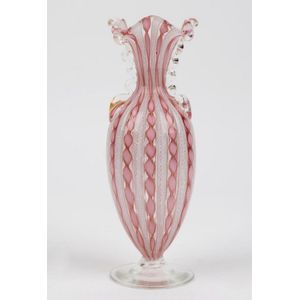
Mid 20th Century Murano Latticino Glass Vase (22cm Height)
Murano latticino glass vase, mid 20th century, 22 cm high
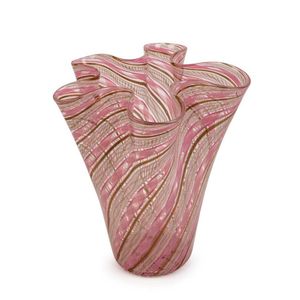
1950s Venini Pink & White Latticino Murano Glass Vase
Venini pink and white latticino Murano glass vase with gold inclusions, circa 1950s, 26 cm high, 22.5 cm wide

1950 Murano Glass Dancing Figures with Latticino and Aventurine
A pair of Murano glass figures, man and woman dancing, with latticino and aventurine inclusion, circa 1950. Height 36 cm. (2)

Mid 20th Century Murano Latticino Fluted Dishes with Zanifirico Ribbons
A pair of Murano latticino fluted dishes, mid 20th century, the zanifirico latticino dishes with blue and pink ribbons, in the style of Salviati, the largest 10 cm diameter
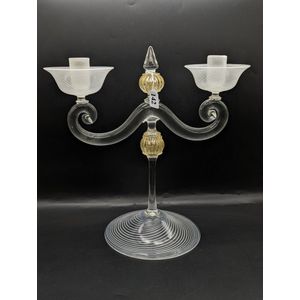
Latticino Swirl Glass Candelabra with Gold Aventurines
Venetian glass candelabra, twin branch latticino white swirls with clear stem scrolled branches with gold aventurines., height 32.5 cm
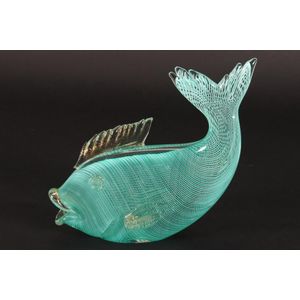
Latticino Murano Glass Fish Sculpture
Murano glass figure of a fish, depicted resting on stomach with raised tail, in latticino glass, in tones of aqua and white, with gilt accents, height 21 cm

Green and White Latticino Glass Plate
Venetian latticino glass plate in green and white. 17 cm diameter.
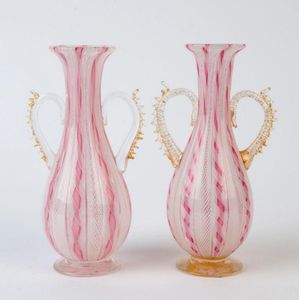
Pink and White Murano Glass Vases, Mid 20th Century
A near pair of pink and white latticino Murano glass vases, early to mid 20th century, 15 cm high

Cranberry Swirl Latticino Glass Bowl
A latticino heavy glass bowl, possibly Czech clear with white latticino and cranberry swirls highlighting the 'torn' rim. Diameter 19 cm

Black and White Latticino Bowl by Archimede Seguso Murano
Archimede Seguso Murano latticino bowl (attributed) clear glass with black and white latticino stripes. Circa mid 20th century. Excellent condition. 7 x 19 cm

Green Murano Glass Vase with Gold Flecked Scalloped Rim
A large Murano glass vase ovoid with trumpet mouth. Millefiori latticino adventurine in predominantly green, the scalloped rim and base with gold flecking, height 34 cm

Pink and Aventurine Latticino Glass Handkerchief Vase
A Murano latticino glass handkerchief vase clear with pink and aventurine canes and lattimo latticino. Foil label on pontil. 15.5 x 17 cm
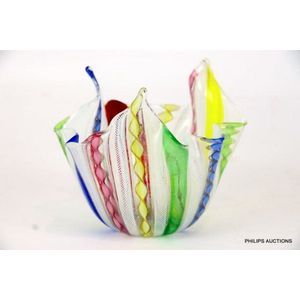
Multicolour Murano Latticino Handkerchief Vase
A Murano Latticino handkerchief vase, circa 1950s, the exquisite multicolour fazzoletto (handkerchief) vase, decorated with alternating stripes of white zanfirico lattice filigree, red candy cane and blue, green, pink and yellow ribbons trimmed with…

Candy Cane Latticino Bowl by Murano Fratelli Toso
Murano Fratelli Toso bowl, decorated with candy cane, red and white latticino

Salviati Murano Glass Pitcher with Zanfrico Decoration
Murano glass pitcher, combination of latticino and ribboned cane multicoloured internal decoration using the zanfrico technique. Attributed to Salviati master glass craftsman
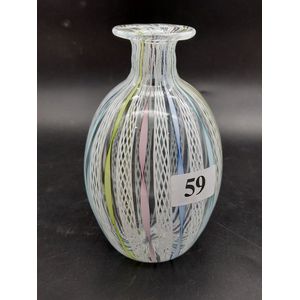
Latticino Zanfrico Vase with Twisted Ribbons
Murano Latticino Zanfrico vase, superbly decorated with blue, green and pink twisted ribbons interspersed by latticino canes

Multicolour Murano Glass Bowl by Fratelli Toso
Murano glass bowl, Venetian latticino and multicolour cane dish attributed to Fratelli Toso

Bronze Swirled Latticino Glass Vase by La Fenice
Murano Vetreria La Fenice vase, Latticino and bronze swirled full body decoration on clear glass body. Original manufacturers label to base, height 28 cm

Murano Latticino Glass Vase by Barovier & Toso
A Murano Latticino glass vase by Barovier & Toso, of cylindrical fluted form, internally decorated with geometric designs, etched 'Barovier & Toso Murano' to base, height 23 cm
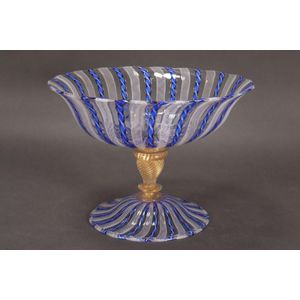
Pauly Venezia Murano Latticino Glass Comport
Murano Latticino glass comport, of flared form set above a knopped stem and domed circular foot, accented with blue and gold twist accents, signed Pauly Venezia, height 20 cm and diameter 28 cm

Multicoloured Murano Glass Bowl, 20th Century
A Murano Multicoloured cased glass bowl, second half 20th century, a rectangular bowl of stretched form with curled corners and a circular well, rich green to the underside, splashed with stretched murrines, latticino swirls, with silver aventurine flecks…

Aventurine and Latticino Murano Glass Comport
Murano glass footed comport with Aventurine and Latticino inserts, height 16.5 cm, diameter 25 cm

Westcott & Latticino Art Glass Vases
An Australian art glass vase by Carrie Westcott, late 20th century together with red ground latticino art glass vase the tallest 32 cm high

1960 Italian Murano Glass Latticino Vase, 15cm High
Murano glass latticino vase, Italian, circa 1960, original foil label 'Murano glass, Made in Italy, 15 cm high

Salviati Moon Flask with Latticino Decoration
Murano glass moon flask with stopper, white Latticino decoration, gold Flecking, (probably Salviati), height 23 cm

1960s Venini Murano Latticino Glass Handkerchief Vase
Venini Murano pink and green latticino glass handkerchief vase, Italian, circa 1960s, 16 cm high, 30 cm across

Pink Latticino Glass Handkerchief Vase by Venini Murano
Venini Murano pink latticino glass handkerchief vase, Italian, circa 1981, engraved 'Venini, Italia, '81', 27 cm high, 34 cm across

Venini Murano Pink & White Latticino Handkerchief Vase
Venini Murano latticino glass pink and white handkerchief vase, Italian, circa 1960s, labelled 'Venini Murano made in Italy', 25 cm high, 32 cm across

Mid-century Venetian Latticino Glass Bowl
A Venetian Latticino glass bowl mid-20th century, height 5.8 cm, diameter: 11.5 cm

Purple and White Venini Latticino Glass Bowl (1950s)
A circa 1950s Venini Latticino glass bowl, in purple and white colourway, 12 cm diameter

1960's Venini Murano Blue Latticino Handkerchief Bowl
A 1960's Venini Murano latticino handkerchief bowl, of fine sapphire blue and white lattice canes within the clear body, traditional scalloped form, acid etched mark to the ground pontil. Height approx. 7.5 cm, diameter approx. 11 cm.
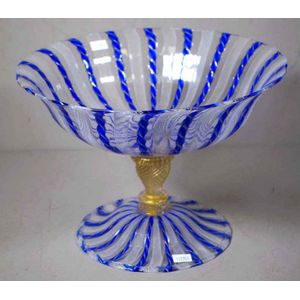
Vintage Murano Latticino Bowl with Gold Detail
Superb large vintage Murano latticino footed bowl, cobalt blue with gold aventurine detail, height 20 cm, diameter 28 cm

Latticino Swirl Glass Scent Bottle with Brass Lid
Scent bottle. Latticino swirl glass, brass ornate lid, length 8 cm
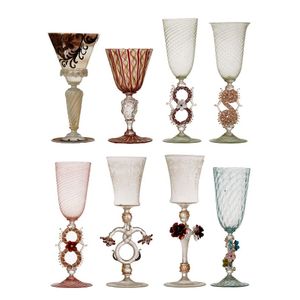
Assorted Venetian Glass Stemware Collection (8)
A fine collection of eight varying Venetian glass stemware, in etched and latticino designs, (8)

Murano Latticino Glass Ewer with Gold and Copper Inclusions
A Refined Murano Latticino glass ewer, second half 20th century. of slender tapering bottle design with an elongated stretched rim and an applied clear scroll handle with gold foil inclusions, the body with white zanfirico and twisted pink ribbons with…
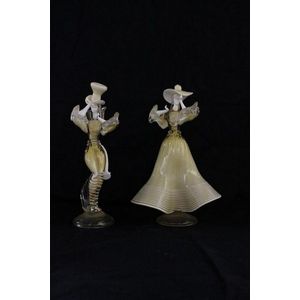
Murano Glass Dancing Figurines with Latticino & Aventurine (1950s)
A pair of Murano glass Costumed dancing figurines, with Latticino and Aventurine c.1950's. Height 35 cm
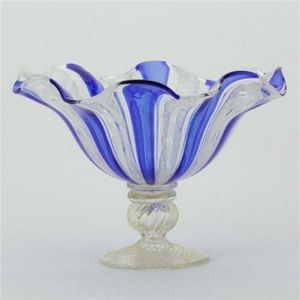
Murano Latticino Ribbon Glass Footed Dish
Murano Latticino ribbon glass footed dish with an aventurine swirl pattern foot. Condition, good, minor wear to the base, height, 12.9 cm

Murano Venini Latticino Handkerchief Vase, Signed, Mid 20th Century
A large Murano Venini Latticino handkerchief, vase, mid 20th century, signed stencilled acid signature to base. Height 30 cm, (slight AF rim)

Lattacino Glass Comport Dish - 12cm Diameter
Venetian Lattacino glass comport dish, Diameter 12 cm approx

Mauve and White Latticino Glass Bowl by Venini
A mid-20th century Italian Venini latticino glass bowl, squared circular form, mauve and white fine lattice canes, acid etch mark. 13 cm x 13 cm x 7 cm

Venini Latticino Glass Bowl & Blue Glass Jug
A c.1950 Italian Venini latticino glass bowl together with an old glass jug, the bowl with clear and blue crossed panels, acid etched signature to base, the small jug hand blown, diamond form panels, blue applied rim.
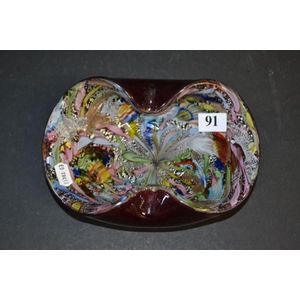
Colorful Latticino Swirls Murano Glass Shallow Bowl
Murano glass shallow bowl decorated with multi-coloured glass and latticino swirls

Multi-Coloured Latticino Swirls Murano Glass Shallow Bowl
Murano glass shallow bowl decorated with multi-coloured glass and latticino swirls

Colorful Latticino Murano Glass Shallow Dish
Murano glass shallow dish decorated with multi-coloured glass and latticino swirls

Venetian Glass Leaf Bowl with Colorful Sweets
A delightful Venetian glass leaf bowl with Sweets, the latticino crimp edged leaf bowl holding a collection of wrapped 'Sweets' in myriad colours and in varying pulled, applied and spatter designs. Height 5.5 cm. Width 17.5 cm. Depth 14 cm

Murano Latticino Vase with Gold Bands
An antique Murano Latticino vase, late 19th century, with a slender trumpet neck, and a baluster body above a pedestal foot, with a fine white latticino spiral throughout enhanced with gilded bands. Height 23.5 cm

Gold Inlaid Latticino Murano Glass Figures
Pair Murano glass figures, Each standing 23 cm high. Latticino technique with gold inclusions

Maroon and White Latticino Glass Vase by Venini (1960)
Venini Latticino glass vase, circa 1960, with a striped cross-hatched filigree design in colours of maroon and white. 28 cm high.

Yellow and White Latticino Glass Bowl from Murano
An Italian Murano small glass bowl, circular, decorated with latticino radiating swirls in bright yellow and white. Indistinct etched mark. Diameter 14 cm.

Italian Latticino Twin Handled Bowl, 1940
A white Latticino twin handled bowl, Italian, circa 1940. 93 cm high

Venini Latticino Uovo Table Lamp, 1950s Italian Design
A Venini latticino Uovo table lamp, Italian, circa 1950. 47 cm high







 Loading more...
Loading more...